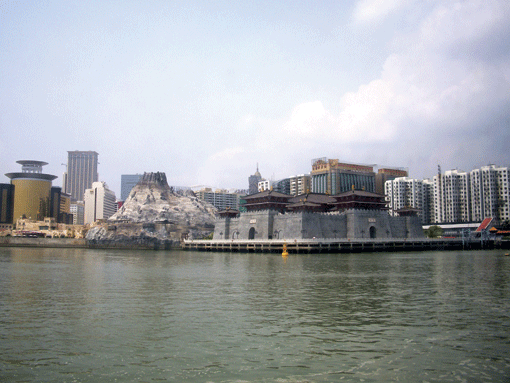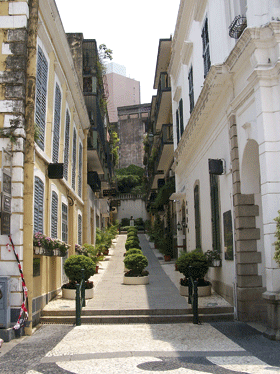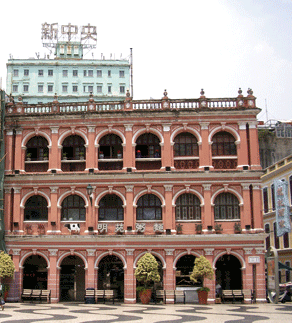
Travel
Macau
Monuments and Squares

Macau is often dismissed as ‘the Las Vegas of the East’. For sure, there are a great many aspects of this tiny, wealthy Special Administrative Region of China which resembles that American city. Macau has a history and culture which Las Vegas cannot even begin to match.
By: Rufaida Javid
For a territory that is just 29.2 sq km in size, Macau boasts a wealth of monuments and cultural squares. In fact, you need at least four days to fully appreciate it. The first thing that a visitor is struck by on arrival at the relatively small but pretty efficient airport is the signboards—they are in Cantonese and Portuguese. 
Indeed, every official document, hoarding or billboard is in Cantonese and Portuguese. What’s the fuss about that, you may ask. Macau was after all a Portuguese colony for 400 years. That is true, but the fact is that you can stay for months in Macau and not hear a word of Portuguese being spoken! Not only did we not meet any person who spoke Portuguese, they didn’t know anyone who did. But the authorities insist on it being given equal status to Cantonese—which is spoken by nearly all inhabitants of Macau—as one of the two official languages. And this is a testament to the influence Portugal historically have had on Macau.
The Portuguese first arrived here in the 16th century, making Macau the oldest European settlement in the Far East. Initially the Chinese allowed a Portuguese settlement in Macau, but the colonizers soon established a municipal government. In 1547, when China banned trade with Japan, it was the Portuguese traders who, as ‘neutral outsiders’, made a fortune carrying goods to and fro between China and Japan. The Europeans continued to pay customs and rent to China until 1849, when Lisbon declared Macau “independent”. In 1887, the Manchu government in China recognized Portugal’s “perpetual occupation” of the territory and signed the ‘Protocol of Lisbon’. After the communists came to power in China in 1949, they declared the protocol null and void and demanded Macau’s return to Chinese sovereignty.
Finally, after the death of Portuguese dictator Antonio Salazar in 1970, negotiations began for Macau’s eventual handover to Beijing. This happened in 1999, when the territory, like neighboring Hong Kong in 1997, became a Special Administrative Region of the People’s Republic of China. 
Though the former colonial masters have gone, they have left behind a legacy so strong that wandering around town, you can be forgiven for thinking you are in Lisbon. Your walking tour of Macau—the city is thankfully very pedestrian-friendly—should begin at the fabulous Senado Square, which is part of the historic center and was declared a UNESCO World Heritage Site in 2005.
The colonial-era-government-buildings here are as mesmerizing as the unique flooring, which is a wave-patterned mosaic of stones, set in yellow and black. At any time of the day, you will be rubbing shoulders with trendy teenagers humming to the tunes on their iPods or young executives doing what they do best—shopping. Macau, like Hong Kong, is a shoppers’ delight. From traditional ware to all the modern clothes and gizmos, shops and malls here offer everything at good prices.
As you walk along the cobbled path, you come across old churches and the excellent Museum of Macau, which simply must not be missed. The entrance fee is Macau Pataca 30 (about SR 15), but it is money well spent. I found the maps used by 16th and 17th seafarers particularly interesting, as I did the apparatus that teaches you to say the word ‘tea’ in 17 languages— including Arabic—at the press of a button! 
Unfortunately, we didn’t get many opportunities to sample the famed culinary delicacies of the territory due to a serious dearth of halal restaurants: we didn’t come across any in our 3-day stay. Hence for 3 days and 3 nights, McDonalds veggie and fish burgers were all we had! The contrast to multicultural Hong Kong, with its magnificent halal Arabic, Chinese and South Asian restaurants, was telling.
Getting There
We flew in from Malaysia. But the easiest way to get to Macau from Saudi Arabia is by flying to Hong Kong and taking a ferry from there (about SR140 return). The ferries are fast and comfortable, and the ride takes just an hour. These ferries also leave for the main ferry terminal in Macau from the Hong Kong airport itself.
Getting Around
Macau has a fully functional public transport system—no metro though—and taxis are also easy to find.
Currency
Since it is likely that you will be traveling to Macau from Hong Kong, there is absolutely no need to change your Hong Kong dollars to Macau patacas. The exchange rate of both currencies is the same and every shop, restaurant, hotel and all taxi drivers accept Hong Kong dollars.
Visas
Citizens of most nationalities get a free, 30-day visa on arrival at Macau airport and ferry terminals.